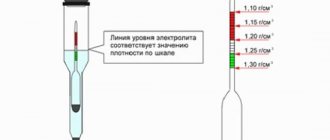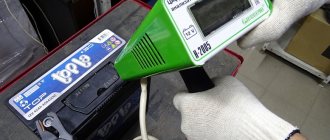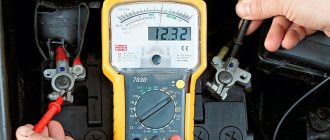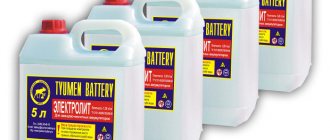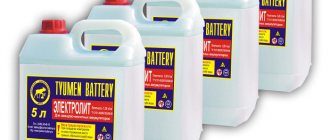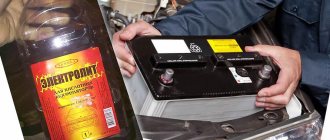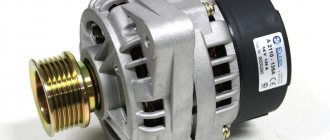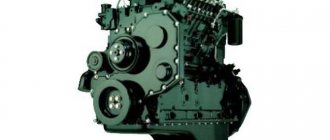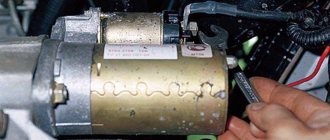In what volumes is electrolyte sold?
Now it’s not such a big problem to buy this liquid, you just need to sit down and go to a specialized store that sells batteries; it’s unlikely to be available in ordinary spare parts.
Basically it is sold only in two containers, these are 1 liter (bottle) and 5 liters (canister). If you were repairing, say, eliminating a short circuit, you only need to fill one jar, then 1 liter will be enough for you, as they say “for the eyes.” The cost ranges from 50 rubles for a liter bottle and up to 200 for five liters.
But if for some reason you need to change the entire volume, then it all depends on the size of your battery and its power.
Electricity storage in a car
Modern cars with gasoline and diesel engines are equipped with a lead-acid battery, which consists of lead electrodes and electrolyte.
As a rule, a battery intended for passenger cars consists of 6 elements connected in series. Each link has an electromotive force of about 2.1 volts. It is easy to calculate that the nominal battery voltage is 12.6 volts, the amount of electrolyte in battery 60 is about three liters, and battery 132 is about ten liters.
The main parameter of a battery is its capacity, expressed in ampere-hours (Ah) and starting current in amperes (A). The capacity depends on the discharge mode, in connection with this, a standard has been introduced for the calculation of 10 hours, i.e. a 55 Ah battery will be discharged within 10 hours, with a current consumption of 5.5 amperes, and the volume of electrolyte in the 55 battery is approximately 2.5 liters.
The current source in the car provides electricity to electrical devices, sensors, and lamps while parked (when the engine is not running) or when the crankshaft speed is too low. Thus, it is clear that when the car starts, the starter and ignition system use current only from a stationary power source. Moreover, it allows, for example, listening to the radio while the car is parked. While driving, its role ends; the only source of current is the generator.
Batteries are often thought of during winter with the onset of severe frosts, because they disappoint many drivers when the temperature drops to several degrees below zero. This happens because in cold weather the storage capacity decreases sharply, causing problems with starting the engine. Under extreme conditions, the acid solution may freeze, causing irreversible damage to the battery.
We recommend: How to clean car battery terminals
Once upon a time there was a custom that during frosts and low temperatures, the driver removed the battery from the car while parked and took it to a warm room for the night, and installed it only immediately before the trip.
Nowadays, some manufacturers do not recommend tampering with the battery yourself, because disconnecting it can damage the electronics and erase the driver memory.
Dependence of volume and current strength
It is clear that the volume of 45Am/h will be much less than that of the 190Am/h option. If you dig into the physics, a powerful battery requires more lead (which is placed in a more bulky case), which is why the dimensions of the 190 version will be almost 4 - 5 times larger than, say, the same 45. And where there is more of this metal, more electrolyte is needed to effectively accumulate voltage.
However, if you think about the question - how much do you need to buy in order to guess for all options (take it as if with a reserve), the answer suggests itself. After all, the maximum canister, which is sold in only five liters, is therefore suitable for almost all models. In order not to be unfounded, I want to analyze the most popular “Amperages”.
Let me make a reservation right away: there are slight differences depending on the manufacturer, but they vary by insignificant grams.
Specialist support
Lack of access to banks does not mean that the battery cannot be serviced.
The service center technicians will test it and, if necessary, try to restore it. This is not a difficult operation, but no doubt requires a lot of time and practice. Do not underestimate the low level of electrolyte in the battery, even when it seems that it is slightly below normal. However, this greatly affects the performance of the battery; only professionals know how much electrolyte a 60-volt battery needs, so they can be trusted with this capricious part of the car, which often brings surprises.
What should a car owner do when it turns out that the battery requires charging? To do this, you need to remember some rules:
- Firstly, first disconnect the negative and then the positive poles.
- Secondly, when dismantling, do not tilt the battery to reduce the risk of electrolyte leakage.
- When connecting the battery to the charger, it is recommended to charge it in a well-ventilated area because hydrogen and oxygen are released during the charging process.
We recommend: Titan Euro Silver car battery
As a rule, it takes several hours to charge; to avoid overcharging, it is better to use a rectifier that will automatically adjust the charging process and time.
Car dealerships sell batteries that do not require maintenance. The expression "no maintenance" means that this device has less electrolyte loss compared to a traditional acid battery.
But this does not exempt the user from caring for it and observing the basic rules of its operation.
Often, inexperienced owners of passenger cars install a battery with a capacity higher than that recommended by the manufacturer. For example, instead of the recommended 6 st-55, they install 6 st-75, knowing how much electrolyte is in the battery 75, but do not understand that it is too large and will obviously not be fully charged, therefore it will wear out faster than its smaller counterpart.
How to handle the battery
In order for the electric current storage device to serve for a long time, it is necessary to follow some recommendations from specialists:
- In winter, before starting the engine, turn off all unnecessary electrical appliances (radio, lights, fans).
- Do not load the power source by rotating the starter for a long time. Perform short intervals of up to five seconds and allow it to rest for about half a minute between individual samples.
- Remember to press the clutch during this action, this will significantly facilitate the rotation of the engine crankshaft.
- When driving a car in city mode, sometimes it is worth taking a longer trip so that the battery has a chance to fully charge.
Correct charging
It is not normal when the car cannot be started without outside help.
The energy balance of the vehicle must be constant. The battery should be charged properly while the engine is running, and the generator should produce as much current as the car consumes. However, in practice this is not always the case. Therefore, the same battery in one car works without problems even for 8 years, but in another, already in the second winter season, it often fails the driver. This is because the battery, firstly, does not tolerate constant incomplete charging, and secondly, current is used uneconomically, for example, music, light while parked.
We recommend: How to properly start a car in severe frost
Nothing harms a battery more than frequent and prolonged discharges, undercharging or overcharging. In all these cases, the cause may be too little or too much charging current. This is easy to check in a workshop and simple to fix. Take care of your battery by following the recommendations of professionals:
- Do not approach with fire while charging, there is a danger of a flash of released hydrogen.
- You cannot connect the poles with a piece of metal.
- Leaving a car without recharging the storage device for a period of more than two months is risky.
- Securely attach the battery to the car body.
- It is prohibited to overload the device by charging with too much current or voltage.
- Operate the starter with too much current consumption.
Do not put the terminals on the battery by hitting it from above . It is necessary to unscrew the screw, straighten the seat on the cable with a screwdriver, and carefully place it on the electrode.
If it evaporates, what should I do?
Many people mistakenly believe that if the electrolyte level has decreased (due to evaporation), then they need to buy a little more and add it up to the level. Guys, this is not entirely correct.
This liquid consists of acid and water, it is the water that evaporates and therefore the level drops, but the sulfuric acid remains and seems to increase in concentration. In order to return the desired level, you only need to add distilled water , but in no case - not electrolyte! If you add it, you will increase the concentration of acid, which can damage your battery.
Take proper care of it and it will last you a very long time. This is where I end your AUTOBLOGGER.
Similar news
- How long does it take to change the battery?
- What happens if you mix up the battery terminals? Installed on…
- The battery voltage drops. Why? After all, there is no load
Add a comment Cancel reply
How to check the electrolyte level in a battery?
An example of an acid battery with a built-in indicator showing the electrolyte level
There are three ways to find out the electrolyte level in the battery. In two cases, there is no need to remove the battery from the car. After all, before measuring, you should take a closer look at the battery itself.
Firstly, some serviceable car acid batteries have a special indicator. It shows several of its states: normal, low electrolyte level (you need to add water), low electrolyte density (you need to charge). Secondly, some batteries with a white or light-colored case have MIN and MAX marks. Such batteries allow you to assess the electrolyte level by eye, thanks to the relative transparency of the case.
But most often the electrolyte level is determined by visual inspection . To do this, remove the battery from the car, unscrew the caps from the “cans” and look inside. Normal or reduced levels can be determined in two ways.
What is the normal electrolyte level in the battery?
How to add distilled water when the level mark is missing
Some batteries have special “tab” indicators. They should be covered with electrolyte by 0.5 centimeters, but no more. If there are none, then be guided by the immersion of the plates in the liquid. The normal electrolyte level should be 15-20 millimeters above the edge of the plates . If the plates are not coated, this is very bad; the critically low electrolyte level should be restored immediately. But in order to understand what to pour, water or acid, and how much to add, you should measure the exact level and density of the electrolyte!
How and what to measure
To determine how much fluid is in the battery, special glass measuring tubes from Soviet “battery kits” are used. Or you can take the body of a regular transparent plastic pen. Make a mark on one edge at a level of 2 centimeters from the edge (with a notch or marker). Insert the tube/handle into the jar, pinch the top edge to block the air and lift up. Now visually assess the liquid level - how much lower it is than 2 centimeters.
Electrolyte level gauge
Checking the electrolyte level with a ruler
A clear example of how to measure electrolyte using a pen
During the inspection, you can also assess the condition of the electrolyte. It must be transparent. If the liquid is cloudy or dark, it means destructive processes have begun in the battery and further manipulations do not make sense. The battery needs to be replaced.
The density of the electrolyte can be measured either with a hydrometer (most often used) or with a refractometer. You can purchase it at most auto supply stores and it will be useful for assessing the quality of not only this, but also other vehicle fluids.
To ensure accurate measurements, you need to check the electrolyte level and density only after the battery is fully charged from the charger!
What else is dangerous about low concentration?
I told a little from above that a low electrolyte concentration tells us about a discharge, and it leads to sulfation of the plates. This is very bad!
Another disadvantage of a low value is the low freezing threshold. Your battery may simply freeze, which is even worse. After all, the value of 1.17 g/cm3 has a freezing threshold of approximately -5 - 10 degrees Celsius, and if it turns up - 20! What's not uncommon? Ice will break the plates and even the body. After freezing, it is very difficult to restore the battery. This is almost 100% failure of the battery.
Now let's watch a small but useful video.
Actually, I’ll end here, I think my article was useful to you. Read our AUTOBLOG.
Similar news
- Which battery is better maintained or maintenance free? Rule...
- How to test a battery with a load fork. By car, floor...
- How to restore a car battery. We do it at home...
What is put into a car battery?
Lead-acid car batteries of the WET group use an aqueous solution of sulfuric acid (H2SO4) as the electrolyte. There are also AGM batteries in which fiberglass is impregnated with electrolyte. And another type of lead-acid battery is GEL. In them, the electrolyte is transferred to a gel-like state using the addition of silicon oxide. The electrolyte level requires monitoring in WET car batteries. Everything said below is true for these batteries.
Electrolyte level in battery
The electrolyte is a solution of sulfuric acid in distilled water with a content of 30-35% (wt.). Regular tap water is not suitable. To prepare the electrolyte, distilled water is used, which is purified from impurities. If impurities (salts, metal oxides) get into the solution, this will lead to parasitic reactions, corrosion of the plates and a reduction in the service life of the battery.
Electrolyte for lead-acid batteries
Electrolyte for car batteries is sold in auto stores already in diluted form (density 1.29 g/cm 3 ). In production, sulfuric acid has a higher concentration. It is obtained in 2 stages. First, the concentration is brought to 70%, and then 98%. In this form it is stored until used for various purposes. Car batteries are just a small area where sulfuric acid is used. It is used in various spheres of the national economy. Therefore, different grades of sulfuric acid are produced. They are given below (concentration and density are indicated in parentheses):
- Tower or nitrous (75%, 1.67 g/cm 3 );
- Contact (92.5─98%, 1.837 g/cm 3 );
- Oleum (104.5%, 1.897 g/cm 3 );
- High percentage oleum (114.6%, 2.002 g/cm 3 );
- Battery (92─94%, 1.835 g/cm 3 ).
We recommend that you additionally read the article on how to service car batteries yourself.
What is an electrolyte
How much does a VAZ 2109 engine weigh?
As I already wrote above, this is a liquid that consists of special components. Actually, there are only two of them - sulfuric acid and distilled water. They are placed approximately in a combination of one to two. That is, one mass fraction of acid and two parts of water (if we take the percentage ratio, then 35% to 65%). It is this ratio that causes the plates (plus and minus) to accumulate charge.
But what is density?
It’s simple - density is the ratio of acid and water; if you measure it with a special device (hydrometer), it will show the following value (35/65%). This means that the ratio is correct and no adjustment is required. That is, there is no need to add either water or acid.
But it is practically not indicated as a percentage, but is measured in grams per centimeter cubed (g/cm3), this tells us about the concentration of acid (grams) in one cubic centimeter of electrolyte.
Battery selection
If the power source in your car is disappointing more and more often, most likely the only way out of the situation is to buy a new one. Auto repair service consultants recommend choosing products from well-known, reputable manufacturers that provide quality and ease of use, for example, a 6 st-62 battery, it has a capacity of 62 a/h, and a starting current of 550 a/h; how much electrolyte is in the battery is 62 specified in the manufacturer's operating instructions.
Most often, a 6 st-60 storage device is installed on a passenger car; it has a capacity of 60 a/h; how many liters of electrolyte in a 60 battery can be found in the product data sheet.
The first step in selection is identifying the right technology . There are currently three main types of batteries on the market. Battery with liquid electrolyte. This is a traditional design that is installed on cars by drivers traveling long distances. AGM batteries. These batteries are excellent for drivers of hybrid vehicles that are used intensively.
Gel DC sources are characterized by the use of silica gel, which seals the electrolyte. They are used where long-term power is required, such as in caravans, but are not suitable for use as starter batteries.
